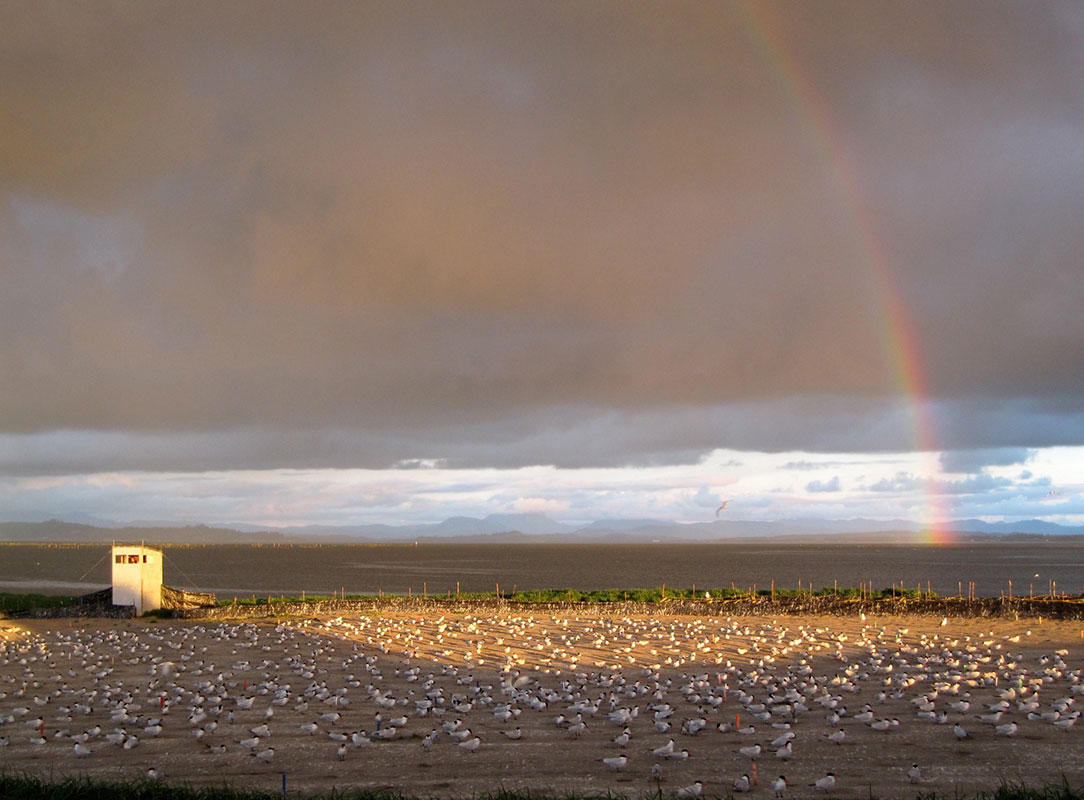 Avian Predation in the Columbia Plateau Region, 2019
Avian Predation in the Columbia Plateau Region, 2019
From 2014-2018, the U.S. Army Corps of Engineers – Walla Walla District (Corps) and the Bureau of Reclamation (Reclamation) funded efforts to implement and evaluate the Inland Avian Predation Management Plan (IAPMP). The goal of the management plan was to reduce predation on Endangered Species Act (ESA)-listed juvenile salmonids (Oncorhynchus spp.) by Caspian terns (Hydroprogne caspia) nesting at colonies in the Columbia Plateau region (CPR), namely Crescent Island on the Columbia River and Goose Island in Potholes Reservoir, the two largest tern colonies in the region. The objectives of the plan were to use passive nest dissuasion techniques (i.e. fencing, stakes, rope, flagging, woody debris, and vegetation plantings) to eliminate tern nesting habitat on both islands and to use active nest dissuasion techniques as an adaptive management tool to insure terns were not able to establish colonies at either site. Concomitant with management implemented as part of the IAPMP, the plan called for monitoring and evaluating the efficacy of those management components and actions at both the colony‐ and system‐level, including measuring changes in Caspian tern nesting distribution and colony sizes in the CPR, as well as tern impacts on ESA-listed juvenile salmonids originating from the Snake and Columbia rivers.
In 2019, the Grant County Public Utility District (GPUD) and the Priest Rapids Coordinating Committee (PRCC) supported continued implementation and monitoring of the IAPMP, so that advances made in reaching the goals of the plan during 2014-2018 were not lost and further reductions in smolt losses to tern predation could be achieved. Additionally, the GPUD and PRCC funded efforts to determine the impacts of unmanaged piscivorous colonial waterbirds (i.e. California gulls [Larus californicus], ring-billed gulls [L. delawarensis], double-crested cormorants [Phalacrocorax auratus], and American white pelicans [Pelecanus erythrorhynchos]) on smolt survival and to assess the system-wide, cumulative impacts of avian predation on smolt survival. In total, this study will inform adaptive management actions that could be carried out to maximize the benefits to ESA-listed juvenile salmonids by managing avian predation in the CPR.
The primary objective of the sixth year of implementation of the IAPMP was to limit the numbers of Caspian terns breeding at Goose Island and surrounding islands in Potholes Reservoir, and on Crescent Island in McNary Reservoir, to less than 40 breeding pairs each to reduce predation impacts of terns on ESA-listed juvenile salmonids in the CPR. To accomplish this task, the availability of suitable Caspian tern nesting habitat was nearly eliminated at these sites by installing a variety of passive nest dissuasion materials on Goose Island and elsewhere in Potholes Reservoir, and vegetation growth (planted in 2016) on Crescent Island prior to the 2019 nesting season. On both Goose and Crescent islands, passive nest dissuasion materials and/or vegetation covered all areas where Caspian terns have previously nested, as well as all areas of open, sparsely vegetated habitat that might be used by ground-nesting Caspian terns or gulls (Larus spp.). Finally, an island in northeastern Potholes Reservoir that was used by Caspian terns for nesting in 2016, and one additional nearby island where terns were observed prospecting in 2018, were covered in passive dissuasion to prevent terns from nesting at those sites in 2019. Once Caspian terns arrived to initiate nesting in 2019, active nest dissuasion (i.e. human hazing) was used to dissuade terns from nesting on Goose Island and other islands in Potholes Reservoir. No hazing has been required to prevent Caspian terns from nesting on Crescent Island since the onset of management in 2015.
Despite the use of passive and active nest dissuasion techniques on Goose Island and elsewhere in Potholes Reservoir, some Caspian terns continued to display high fidelity to Potholes Reservoir as a nesting area in 2019, the sixth year of management at this site. This fidelity is likely due to Caspian terns, a relatively long-lived species (i.e. some individuals having of life span of more than 20 years), having first nested on Goose Island in 2004 and the persistence of a large gull colony on the island, both before and after management, which continues to attract prospecting Caspian terns to the site. Another factor that might explain the strong fidelity of Caspian terns to the Potholes Reservoir area is the paucity of alternative Caspian tern colony sites in the vicinity. As was the case in 2015-2018, Caspian tern use of Goose Island for roosting and nesting in 2019 was largely limited to areas near the island’s shoreline that became exposed during the nesting season as reservoir levels receded. Despite high fidelity of terns to the area, active nest dissuasion (hazing) and collection of any tern eggs laid (under permit) were factors in preventing the formation of a Caspian tern colony in Potholes Reservoir in 2019. This is the fourth consecutive year that nest dissuasion activities initiated at Goose Island were successful in preventing Caspian terns from nesting there; in 2014, 159 breeding pairs nested on a small rocky islet (i.e. Northwest Rocks) immediately adjacent to Goose Island, and in 2015 two breeding pairs of Caspian terns nested under the passive dissuasion near the former colony location on Goose Island. Prior to management (2005-2013), an average of 367 breeding pairs of Caspian terns nested on Goose Island.
In 2019, egg laying by Caspian terns on Goose Island and elsewhere in Potholes Reservoir occurred between 29 April and 5 July. During this period, a total of 20 Caspian tern eggs were discovered at two different locations in Potholes Reservoir; 19 tern eggs were discovered on Goose Island and the surrounding islets and one tern egg was discovered on the colony site used by terns in 2016 in northern Potholes Reservoir. Eight tern eggs discovered were collected under permit, and the remainder were depredated by gulls prior to collection.
As was the case in 2015-2018, passive nest dissuasion techniques (i.e. revegetation) alone were successful in preventing all nesting and roosting by both Caspian terns and gulls in upland areas on Crescent Island during the 2019 nesting season. Prior to management (2005-2013), an average of 403 breeding pairs of Caspian terns nested on Crescent Island. The complete abandonment of Crescent Island by nesting terns beginning in the first year of management was somewhat unexpected because Caspian terns and gulls had nested consistently on Crescent Island for nearly three decades prior to management. One factor that likely contributed to the absence of nesting Caspian terns on Crescent Island was the successful dissuasion of gulls from nesting on Crescent Island during 2015-2019; gulls are breeding associates of Caspian terns and attract prospecting Caspian terns to nest near their colonies. At Goose Island, gull nesting could not be prevented using the passive and active nest dissuasion techniques at our disposal, whereas at Crescent Island gulls never habituated to the nest dissuasion techniques implemented there. Instead, gulls abandoned Crescent Island as a nesting site and some, if not most, of these birds established a new colony on Badger Island located on the Columbia River just one kilometer upriver from Crescent Island in 2015-2019. Similarly, many Caspian terns displaced from Crescent Island relocated to unmanaged colony sites on the Columbia River, including the Blalock Islands in John Day Reservoir (70 river kilometers downriver from Crescent Island) in 2015-2019, where Caspian terns have nested in small numbers intermittently over the last decade.
Aerial, ground, and boat-based surveys were conducted in the CPR to determine where Caspian terns displaced from the managed colonies in Potholes Reservoir and at Crescent Island might attempt to re-nest. In 2019, Caspian terns attempted to nest at three extant colony sites in the CPR that are currently unmanaged. All three of these sites have been used for breeding by Caspian terns previously, including the Blalock Islands complex in John Day Reservoir (379 breeding pairs in 2019; up from the pre-management average [59 breeding pairs] and down from the average during the management period [391 breeding pairs]), Harper Island in Sprague Lake (18 breeding pairs in 2019; up from the pre-management average [8 breeding pairs] and down from the average during the management period [35 breeding pairs]), and on North Rock in Lenore Lake (48 breeding pairs in 2019; up from the pre-management average [0 breeding pairs] and down from the average during the management period [52 breeding pairs]). The former Caspian tern colony sites at Twinning Island in Banks Lake and Badger Island on the Columbia River in McNary Reservoir were not active in 2019. As was the case in 2015-2018, the largest Caspian tern colony in the CPR was on the Blalock Islands, where 87% of all the Caspian terns in the region nested during 2019. Compared to the average size of the Caspian tern colony on the Blalock Islands prior to management (2005-2013; 59 breeding pairs), the colony was 5-11 times larger during 2015-2019.
The total estimated breeding population of Caspian terns in the CPR during 2019 was 445 breeding pairs at three separate colonies. This represents a 49% decline in the regional breeding population size for Caspian terns compared to the pre-management average (873 breeding pairs), and a 30% decline when compared to the average during the management period (640 breeding pairs). Although nest dissuasion actions implemented on Goose and Crescent islands in 2019 were effective in preventing all Caspian terns from nesting at these two colonies, it did not result in a commensurate reduction in the total number of Caspian terns breeding in the region. This was due to the continued use and increase in the colony size at unmanaged sites (i.e. Blalock Islands, North Rock, and Harper island) when compared to pre-management averages. While smaller in 2018-2019, the average Blalock Islands colony size during the management period (2015-2019; 391 breeding pairs) was similar in size to the largest Caspian tern colonies recorded anywhere in the CPR since intensive monitoring began in 2000.
A primary goal of the IAPMP is to reduce predation rates (proportion of available fish consumed) on ESA-listed juvenile salmonids by Caspian terns to less than 2% per salmonid population, per colony. Recoveries of smolt passive integrated transponder (PIT) tags on Caspian tern colonies in 2019 were used to estimate salmonid population-specific (hereafter ESU/DPS) predation rates and to compare predation rates prior to and during tern management actions associated with the IAPMP. To help ensure that ESA-listed Upper Columbia River steelhead – a population that is highly susceptible to tern predation and therefore a suitable population to evaluate the efficacy of management actions – were available for predation rate analyses, 3,784 steelhead smolts were intentionally PIT-tagged and released into the tailrace of Rock Island Dam (RIS) by Chelan County Public Utility District employees in 2019. Numbers of steelhead tagged at RIS in 2019 were less than that of years past but provided a representative sample of the run-at-large for predation analyses in 2019.
Caspian tern predation rate estimates indicated that the goal of achieving rates of less than 2% were met for most, but not all, tern colonies and ESA-listed salmonid ESUs/DPSs in 2019. For the fifth consecutive year, predation rates were zero or close to zero for terns nesting on Goose Island and Crescent Island due to the complete (Crescent Island), or nearly complete (Goose Island and other islands in northern Potholes Reservoir), abandonment of these colony sites. Predation rates at the unmanaged tern colony in Lenore Lake (North Rock) were also less than 2% per ESU/DPS, with the highest rate observed on Upper Columbia River steelhead at 1.0% (95% credible interval [CRI] = 0.6–1.7). Predation rates for the large unmanaged tern colony in the Columbia River on the Blalock Islands, however, exceed the 2% threshold for two ESA-listed ESUs/DPSs, with predation rates of 5.9% (95% CRI = 3.4–10.0) and 3.0% (95% CRI = 1.9–4.7) for Upper Columbia River steelhead and Snake River steelhead, respectively. Predation rate estimates were not available for Caspian terns nesting on Harper Island in Sprague Lake (i.e. we were not granted access to the privately-owned island to recover PIT tags), but just 18 pairs nested on Harper Island in 2019. Based on limited data from years past, Caspian terns nesting on Harper Island are capable of foraging on juvenile salmonids in the lower Snake River, but impacts have been low (< 0.3% for all ESU/DPS), presumably due to the small size of the colony and it’s distance from the lower Snake River (> 60 km).
Comparisons of Caspian tern predation rates on juvenile salmonids prior to and during implementation of the IAPMP indicate there have been benefits to Upper Columbia River steelhead, with predation rates by Goose Island and Crescent Island Caspian terns eliminated during implementation of the IAPMP. There is also evidence that Upper Columbia River steelhead smolt survival has increased in the river reach where Goose and Crescent Island terns forage (Rock Island Dam to McNary Dam). Due to continued high rates of predation by Blalock Island terns, however, impacts to some ESA-listed ESUs/DPSs, particularly those originating from the Snake River, remain as high or higher than those observed prior to implementation of management actions as part of the IAPMP. As such, adaptive management actions will likely be necessary to achieve the over-all goals of the IAPMP in the future.
An investigation of predation rates by other piscivorous colonial waterbird species (California and ring-billed gulls [hereafter “gulls”], American white pelicans, and double-crested cormorants) and colonies indicated that several gull colonies posed a risk to smolt survival in 2019. Predation rates by gulls nesting on Island 20, Badger Island, and Miller Rocks Island were among the highest of any colony evaluated in 2019, with predation rates on Upper Columbia River steelhead, Snake River steelhead, and Snake River sockeye greater than 5% of available fish, depending on the colony and ESU/DPS. For instance, predation rate estimates as high as 10.9% (95% CRI = 6.7-17.7) of Upper Columbia River steelhead and 5.9% (95% CRI = 2.6-11.8) of Snake River sockeye were observed by gulls nesting on Badger Island and Miller Rocks Island, respectively. Conversely, predation rate estimates by double-crested cormorants nesting in Lenore Lake were < 0.1% of available fish and minimum estimates of predation of < 0.2% of available fish were observed by American white pelicans nesting on Badger Island, indicating that not all piscivorous colonial waterbird species and colonies posed a risk to smolt survival in the CPR.
To investigate the cumulative effects of avian predation (predation by all colonies combined) on smolts and to determine what proportion of all sources of smolt mortality (1-survival) were due to bird predation, we conducted a mark-recapture-recovery analysis on Upper Columbia River steelhead that were PIT-tagged and released at Rock Island Dam in 2019. We used previously published methods to jointly estimate predation and survival rates during smolt passage through multiple river reaches and we compared results from 2019 to those in years past (2008-2018). Results indicated that avian predation was often the single greatest source of mortality for steelhead during out-migration from Rock Island Dam to Bonneville Dam, with bird predation accounting for more than 50% of all mortality sources in 10 of the last 12 years (2008-2019), including in 2019. Estimated steelhead smolt losses to piscivorous colonial waterbirds were greater than direct losses associated with dam passage, predation from piscivorous fish, mortality from disease, and all other remaining mortality factors combined. Even after passage through the impounded sections of the middle and lower Columbia River upstream of Bonneville Dam, the impact of piscivorous colonial waterbirds on survival of steelhead smolts in the free-flowing section of the Columbia River downstream of Bonneville Dam was substantial, with Caspian terns and double-crested cormorants nesting on East Sand Island annually consuming upwards of 28% of available steelhead smolts in the estuary. Results indicate that although progress has been made to increase steelhead smolt survival by decreasing Caspian tern predation between Rock Island Dam and McNary Dam, avian predation continues to be a dominate source of smolt mortality in the Columbia River basin.
-Bird Research Northwest
Click here to see full report



